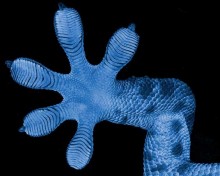
Adhesion is defined as the tendency of dissimilar particles or surfaces to stick to one another where as cohesion is the trendency of similar or identical particles/surfaces to cling to one another. Surfaces can be critical to the process of both adhesion and cohesion and this is where XPS can be used to provide valuable chemical state information leading to better understanding of these processes.
The subject of adhesion is wide ranging and encompasses materiasl as diverse as bio-organisms, microelectronics and inorganic thin films in industries such as aerospace and pharmaceuticals. The breadth of the subject is outlined in a number of high-impact references gathered below using Kratos AXIS instruments.
A biodegradable and biocompatible gecko-inspired tissue adhesive
Alborz Mahdavi , Lino Ferreira, Cathryn Sundback, Jason W. Nichol, Edwin P. Chan, David J. D. Carter, Chris J. Bettinger, Siamrut Patanavanich, Loice Chignozha, Eli Ben-Joseph, Alex Galakatos, Howard Pryor, Irina Pomerantseva, Peter T. Masiakos, William Faquin, Andreas Zumbuehl, Seungpyo Hong, Jeffrey Borenstein, Joseph Vacanti, Robert Langer and Jeffrey M. Karp
ABSTRACT
There is a significant medical need for tough biodegradable polymer adhesives that can adapt to or recover from various mechanical deformations while remaining strongly attached to the underlying tissue. We approached this problem by using a polymer poly(glycerol-co-sebacate acrylate) and modifying the surface to mimic the nanotopography of gecko feet, which allows attachment to vertical surfaces. Translation of existing gecko-inspired adhesives for medical applications is complex, as multiple parameters must be optimized, including: biocompatibility, biodegradation, strong adhesive tissue bonding, as well as compliance and conformability to tissue surfaces. Ideally these adhesives would also have the ability to deliver drugs or growth factors to promote healing. As a first demonstration, we have created a gecko-inspired tissue adhesive from a biocompatible and biodegradable elastomer combined with a thin tissue-reactive biocompatible surface coating. Tissue adhesion was optimized by varying dimensions of the nanoscale pillars, including the ratio of tip diameter to pitch and the ratio of tip diameter to base diameter. Coating these nanomolded pillars of biodegradable elastomers with a thin layer of oxidized dextran significantly increased the interfacial adhesion strength on porcine intestine tissue in vitro and in the rat abdominal subfascial in vivo environment. This gecko-inspired medical adhesive may have potential applications for sealing wounds and for replacement or augmentation of sutures or staples.
PNAS vol. 105 no. 7 Alborz Mahdavi, 2307–2312 doi: 10.1073/pnas.0712117105
High performance piezoelectric devices based on aligned arrays of nanofibers of poly(vinylidenefluoride-co-trifluoroethylene)
Luana Persano,Canan Dagdeviren, Yewang Su, Yihui Zhang, Salvatore Girardo, Dario Pisignano, Yonggang Huang & John A. Rogers
Nature Communications 4, Article number: 1633 (2013)
ABSTRACT
Multifunctional capability, flexible design, rugged lightweight construction and self-powered operation are desired attributes for electronics that directly interface with the human body or with advanced robotic systems. For these applications, piezoelectric materials, in forms that offer the ability to bend and stretch, are attractive for pressure/force sensors and mechanical energy harvesters. Here, we introduce a large area, flexible piezoelectric material that consists of sheets of electrospun fibres of the polymer poly[(vinylidenefluoride-co-trifluoroethylene]. The flow and mechanical conditions associated with the spinning process yield free-standing, three-dimensional architectures of aligned arrangements of such fibres, in which the polymer chains adopt strongly preferential orientations. The resulting material offers exceptional piezoelectric characteristics, to enable ultra-high sensitivity for measuring pressure, even at exceptionally small values (0.1 Pa). Quantitative analysis provides detailed insights into the pressure sensing mechanisms, and establishes engineering design rules. Potential applications range from self-powered micro-mechanical elements, to self-balancing robots and sensitive impact detectors.
Nature Communications 4, Article number: 1633 (2013) doi:10.1038/ncomms2639
The adhesion performance of epoxy coating on AA6063 treated in Ti/Zr/V based solution
Wen Zhu, Wenfang Li, Songlin Mu, Yunyu Yang, Xi Zuo
An environment-friendly titanium/zirconium/vanadium-based (Ti/Zr/V) conversion coating was prepared on aluminum alloy 6063 (AA6063). The epoxy powder coatings were applied on the AA6063 samples with/without Ti/Zr/V conversion coatings via electrostatic spraying. The morphology and composition of the conversion coating were studied by scanning electron microscope (SEM) and X-ray photoelectron spectroscopy (XPS), respectively. The surface free energy components of AA6063 samples were measured by a static contact angle measuring device with Owens method. The adhesion properties of the epoxy coating on AA6063 treated with different conversion times were evaluated using a pull-off tester. The Ti/Zr/V conversion coating was mainly composed of metal oxide (TiO2, ZrO2, V2O5, Al2O3, etc.), metal fluoride (ZrF4, AlF3, etc.) and metal organic complex. The formation time of this conversion coating was reduced to 50 s. After such surface treatment, the samples' surface roughness was increased and the contact angle with water was decreased. Both the surface free energy and the work of adhesion were increased. The adhesion strength between the epoxy coating and AA6063 was enhanced significantly.
Applied Surface Science Volume 384, 333-340
